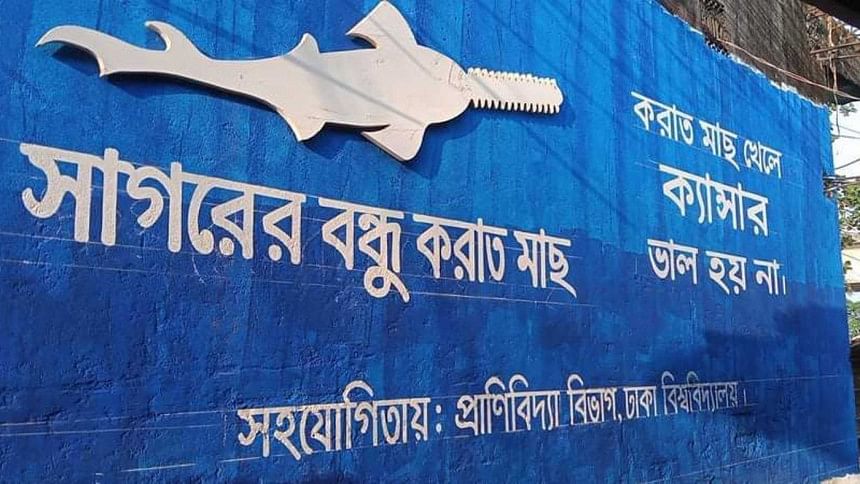Reversing the tide against Sawfish loss from the Bay of Bengal

By the fishing villages of Alipur and Mohipur municipalities in Kuakata, things are afoot. A team of conservationists, field workers, researchers, artists and videographers have put their heads together to drive home a crucial message in favour of Sawfish, lovingly dubbed the king of fishes. They have put together a campaign to help change the conversation around this mystical creature.
Facing a steady decline over the years, this intimidating and strange fish has entirely disappeared from 21 countries that it was historically found in, resulting in an international call for action, according to the International Union for Conservation of Nature (IUCN) Shark specialist group.
Of the five available species in the world, Bangladesh has a record of three Sawfishes and of them, the most widely reported is the Largetooth Sawfish, which has gone extinct from 30 of its range countries making the Bay of Bengal population even more crucial.
According to data collected by Alifa Bintha Haque (Assistant Professor at Dhaka University's Department of Zoology) and her team from all over the Bangladesh coast between 2016 and 2018, at least 40 sawfishes have been landed. And now news of more landings keeps coming in but the data remains to be analysed. What is alarming is their death seems to continue.
This is a sharp contrast to the scene from around a hundred years back. Sawfish rostra were reported to be "all over the beach" of Cox's Bazaar in the 1960s. In the early 1900s, sawfishes in general were reported abundantly in the Bay of Bengal and were considered to be either "very common" or "common" in the estuaries and mouths of the Ganges and Brahmaputra rivers, according to "A Survival Blueprint for the Conservation of the Largetooth Sawfish in Bangladesh" published by the Zoological Society of London.
And to help kickstart a change in the narrative towards conservation, this campaign with the tagline "Save Sawfish—the friend of the seas" that encourages their live release has kicked off in Alipur and Mohipur.
The team mainly comprising of Alifa, a research assistant Nazia Hossain, field coordinator Shawnujjaman Khan and campaign consultant and researcher Arafat Hossain, spreads the tagline in Bangla "Shagor er bondhu korat mach", which loosely translated means, "Sawfish is a friend of the sea".
The campaign essentially aims to change the narrative surrounding Sawfish and the idea is to create a relationship with the species beyond its utility as something to be eaten or sold or as a cure for cancer, which is completely unfounded by the way.
It is important to establish the narrative that this fish is also important for the seas and rivers and since it is important for the seas, it is important for fishers themselves to raise awareness on its ecological importance.
There are four components to this campaign, view-exchange meeting with traders, view-exchange meeting with fishers, door-to-door campaign to sensitise consumers and locals who are neither fishers nor traders and wall-art or murals with some key messages and images intended for everyone.
The campaigners are also providing a hotline number to every fisher, trader or boat owner who comes to the meeting and are providing small clips on their mobile phones which try to capture the message that Sawfishes are important and they need to be saved.
The team is also trying to encourage and train fishers to release the sawfish live if it does get caught in their nets using a live release guide. Another crucial shift in the narrative is the start of a conversation between fishers and traders and consumers that there is actually no cancer curing property in Sawfish meat, which does drive up its demand in the market. Everyone understanding that there is no such benefit will also hopefully make people realise there is really no point in buying this fish at such high prices or any price at all.
The guide has been created from previous research, questionnaire surveys, workshops and interviews with fishers who have previously caught a sawfish and provided their insights on how a live release could be successful. So it is an effort to use their local and practical knowledge to save the sawfish.
During the study period previously, the team always asked fishers how they believed would be an ideal way to release the Sawfish so components incorporated in the live release guide do not come with the preconceived notion that only researchers know best, but it is an amalgamation, a meeting point for both academic knowledge and fisher's local knowledge.
There is also a deliberate effort to avoid telling fishers that they should not catch the fish because it is a punishable offence or it is protected under the law, instead they are trying to drive home a more wholesome narrative—that saving the species will also help the ecosystem to thrive in the long run, or that it does not really have any health benefits. The team are also trying to serve a reminder that fishers too remember catching this mysterious, odd-looking giant of the sea and they risk losing this memory forever.
To push people towards meaningful change is difficult, even if it happens to be something as important as saving nature. A key difference between other animals and a fish is in case of other animals, humans share a different relationship with them or interact differently, they can see them, they have an aesthetic value or religious value. But with most fish, it is more often than not relegated to the realm of food source, believes Alifa B Haque. And so, she is not wrong in saying just how difficult it is to get the conversation for conservation going.
Traders will also get a gift of a wooden sawfish cut-out to act as a reminder of the importance of Sawfish, to make sure the fish gets etched into their psyche.
The campaign is being piloted in Alipur and Mohipur for now, since there is a dearth of resources and these are the areas where researchers found a large number of landings and a prevalence of prejudice among people about the Sawfish. But that does not mean efforts will be concentrated in just one area and it should not be.
The team is also aware that simply doing this campaign is not going to be the answer. This is just scratching the surface. People will be left with meaningful reminders, but the work must continue to ensure everyone in this network of traders, fishers, boatmen, consumers and stakeholders on a national level do their bit.
This is merely the start of the conversation. While such sensitisation programmes must continue across the coastline where sawfishes are caught, landed and eventually traded, so must research.
Because without science, it is hard to decide on conservation actions. And without prompt and decisive action from all fronts, nature may have to count more losses.
Abida Rahman Chowdhury is a journalist at The Daily Star.

 For all latest news, follow The Daily Star's Google News channel.
For all latest news, follow The Daily Star's Google News channel. 



Comments